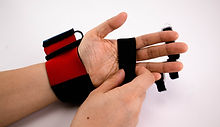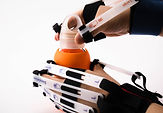
Simulator • Mobility & Dexterity
Arthritis Simulation Gloves
simulate a reduction in the functional ability of the hands. In particular, they use plastic strips to limit the strength and range of motion of the fingers and thumb. Various conditions, such as arthritis, can cause effects like these.

What disability or impairment does this simulate?
These gloves simulate a reduction in the functional ability of the hands. In particular, they use plastic strips to limit the strength and range of motion of the fingers and thumb. Various conditions, such as arthritis, can cause effects like these. As an example, these gloves will make it much more difficult to use a knife and fork, simulating the difficulties that people with arthritis of the knuckles have in gripping small handles.
Below is a compilation of conditions that individuals may experience, and utilising these gloves will aid in fostering empathy:
1
Age-related changes:
As people age, physiological changes occur in their bodies. These changes can affect the joints, muscles, and nerves, leading to reduced dexterity. The natural wear and tear of tissues can decrease flexibility, strength, and coordination.
2
Arthritis and joint conditions:
Arthritis is a common condition among seniors that causes joint inflammation and stiffness. Types such as osteoarthritis and rheumatoid arthritis can significantly impact dexterity, making it difficult to perform delicate motor tasks.
3
Loss of muscle mass and strength:
With ageing comes a natural decline in muscle mass and strength, known as sarcopenia. Weakened muscles can make it challenging to perform precise movements and manipulate objects with dexterity.
4
Cognitive changes:
Age-related cognitive changes, such as memory decline or impaired attention, can affect manual dexterity. Difficulty in recalling sequences of steps or focusing on tasks can impact the ability to perform intricate movements.
5
Medications and side effects:
Some medications commonly used by seniors can have side effects that impact dexterity. Certain medications may cause drowsiness and dizziness or affect fine motor control, making it more challenging to perform tasks requiring dexterity.
It’s important to note that these factors can vary among individuals, and not all seniors will experience the same degree of reduced dexterity. Understanding these reasons can help inform the design of assistive devices, adaptations, and inclusive solutions to support seniors in maintaining their independence and quality of life.
The following list shows some of the effects that you should experience while wearing the gloves:
-
Reduced grip strength: more challenging to hold objects and open/close things
-
Reduced dexterity: difficulty to grip, pinch, turn, lift, and twist objects
-
Restricted range of motion: reduction in opening hand and closing the hand
-
Discomfort or mild pain
Warning:
Reducing your dexterity ability can be dangerous. The Simulation Gloves should not be used in any situations that could cause harm. Please note that impairment simulation cannot convey what it is really like to live with capability loss on an everyday basis. In particular, the gloves do not simulate other common effects such as pain, tremors, loss of tactile sensitivity, and changes in the shape of the hand that occur with ageing. Furthermore, they do not simulate any problems with the wrists. As an example, using a touchscreen keyboard on a mobile phone remains relatively easy with the gloves but is particularly difficult for people with tremors. Therefore, these gloves are intended to be used in combination with other tools as part of a holistic, inclusive design evaluation.
Disclaimer:
The use of empathy tools does not equal the full experiences of having a disability. It is best to aim to engage with your target audience, using the tools to prepare better. The Arthritis Simulation Gloves is not a substitute for professional advice or comprehensive knowledge of ageing and arthritis. Consult a qualified healthcare professional for proper medical management and therapy if you have arthritis or any medical condition. Use it responsibly, acknowledging limitations and potential risks. The School of Design, the Material Resource Centre, and the creators of this simulator and manual are not liable for any injuries, damages, or misuse of the simulator.
Citation:
If you wish to cite this empathy tools manual, you may insert the reference as follows:
Maximo, T; O’Brien, M; Chan, L.S.; Liu, X.; Zhan, W; Lee, W.K.A. (2024). Empathy Tool Manual: Arthritis Simulation Gloves. School of Design, The Hong Kong Polytechnic University.
PDF manual:
Click here to download the pdf. file (4.5MB)


















